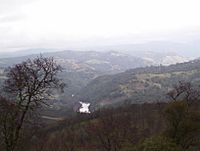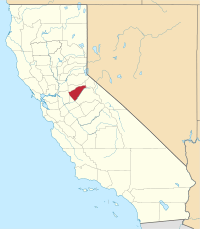Calaveras County, California facts for kids
Quick facts for kids
Calaveras County, California
|
|||
|---|---|---|---|

Calaveras County view
|
|||
|
|||

Location in the state of California
|
|||
| Country | United States | ||
| State | California | ||
| Regions | Sierra Nevada, Gold Country | ||
| Incorporated | February 18, 1850 | ||
| Named for | Spanish word meaning "skulls" | ||
| County seat | San Andreas | ||
| Largest community | Rancho Calaveras (population) Mountain Ranch (area) |
||
| Government | |||
| • Type | Council–CAO | ||
| • Body | Board of Supervisors | ||
| Area | |||
| • Total | 1,037 sq mi (2,690 km2) | ||
| • Land | 1,020 sq mi (2,600 km2) | ||
| • Water | 17 sq mi (40 km2) | ||
| Highest elevation | 8,174 ft (2,491 m) | ||
| Population
(2020)
|
|||
| • Total | 45,292 | ||
| • Density | 43.676/sq mi (16.863/km2) | ||
| GDP | |||
| • Total | .642 billion (2022) | ||
| Time zone | UTC−8 (Pacific Time Zone) | ||
| • Summer (DST) | UTC−7 (Pacific Daylight Time) | ||
| Area code | 209 | ||
| FIPS code | 06-009 | ||
| GNIS feature ID | 1675885 | ||
| Congressional district | 5th | ||
Calaveras County is a county in California, USA. It's located in the Gold Country and High Sierra regions. In 2020, about 45,292 people lived here. The main town and county seat is San Andreas. Angels Camp is the only official city in the county.
The name Calaveras means "skulls" in Spanish. The county was named after the Calaveras River. Long ago, a Spanish explorer named Captain Gabriel Moraga found many bones along the riverbanks.
Calaveras County is home to Calaveras Big Trees State Park. This park protects huge giant sequoia trees. A trapper named Augustus T. Dowd discovered these trees in 1852. When bark from one tree, called the "Discovery Tree," was shown around the world, it made the trees famous. This park became one of the county's first tourist spots.
In 1861, a rare gold mineral called calaverite was found in the county. It was named after Calaveras County.
The famous writer Mark Twain set his story "The Celebrated Jumping Frog of Calaveras County" here. To celebrate this story, the county holds an annual fair and a "Jumping Frog Jubilee." This event includes a frog-jumping contest! Winners get a special plaque in downtown Angels Camp, on something called the "Frog Hop of Fame."
Contents
What Does "Calaveras" Mean?
The Spanish word calaveras means "skulls." The county got its name from the Calaveras River. It's said that Spanish explorer Gabriel Moraga named it during his trips between 1806 and 1808. He found many bones of Native Americans along the river. People thought they might have died from hunger or tribal fights. Another idea is that they got sick from European diseases.
The Stanislaus River, which is the southern border, is named after Estanislao. He was a Lakisamni Yokuts man who escaped from a mission in the 1830s. He gathered a small group of men, but they were defeated by Mexican soldiers.
In 1836, John Marsh and his group explored Northern California. They camped by a river and woke up to find many skulls and bones. They also called the river Calaveras.
Mark Twain stayed in the county for 88 days in 1865. While there, he heard the story that became "The Celebrated Jumping Frog of Calaveras County." This story helped start his writing career and made Calaveras County well-known.
History of Calaveras County
Calaveras County was one of California's first counties. It was created in 1850 when California joined the Union. Some parts of the county later became parts of Amador County in 1854 and Alpine County in 1864.
The county has beautiful landscapes with hills and valleys. It's known for its friendly towns and businesses like farming and construction. Many caverns are here, such as Mercer Caverns, California Cavern, and Moaning Cavern. These caves attract tourists from all over the country. The county also has a growing wine industry, including Ironstone Vineyards, which is the largest winery. People also enjoy mountain sports and performing arts here.
Gold prospecting started in Calaveras County in late 1848. A camp was founded by Henry Angel. He might have been a soldier before becoming a prospector. After hearing about gold finds, he joined a group of miners. Henry Angel first tried placer mining (looking for gold in riverbeds). Soon, he opened a trading post. By the end of 1848, over a hundred tents were around the creek. This settlement became known as Angels Trading Post, and later Angels Camp.
When placer gold ran out, miners found a large gold vein in the area's Mother Lode. This discovery led to the building of a permanent town. Five major mines worked this rich vein: the Stickle, the Utica, the Lightner, the Angels, and the Sultana. These mines were busiest in the 1880s and 1890s. Over 200 stamp mills crushed the gold ore. By the time hard rock mining ended, these five mines had produced over $20 million in gold.
The mineral calaverite was first found in 1861 at the Stanislaus Mine in Carson Hill, Angels Camp. A chemist named Frederick Augustus Genth identified it as a new gold mineral in 1868. He named it after Calaveras County.
Geography of Calaveras County
Calaveras County covers about 1,037 square miles. Most of this area is land (1,020 square miles), and a small part is water (17 square miles). The county has many interesting caves.
Neighboring Counties
- Amador County – to the north
- Alpine County – to the northeast
- Tuolumne County – to the south
- Stanislaus County – to the southwest
- San Joaquin County – to the west
Protected Natural Areas
- Stanislaus National Forest (part of it is in Calaveras County)
Population of Calaveras County
| Historical population | |||
|---|---|---|---|
| Census | Pop. | %± | |
| 1850 | 16,884 | — | |
| 1860 | 16,299 | −3.5% | |
| 1870 | 8,895 | −45.4% | |
| 1880 | 9,094 | 2.2% | |
| 1890 | 8,882 | −2.3% | |
| 1900 | 11,200 | 26.1% | |
| 1910 | 9,171 | −18.1% | |
| 1920 | 6,183 | −32.6% | |
| 1930 | 6,008 | −2.8% | |
| 1940 | 8,221 | 36.8% | |
| 1950 | 9,902 | 20.4% | |
| 1960 | 10,289 | 3.9% | |
| 1970 | 13,585 | 32.0% | |
| 1980 | 20,710 | 52.4% | |
| 1990 | 31,998 | 54.5% | |
| 2000 | 40,554 | 26.7% | |
| 2010 | 45,578 | 12.4% | |
| 2020 | 45,292 | −0.6% | |
| 2023 (est.) | 46,565 | 2.2% | |
| U.S. Decennial Census 1790–1960 1900–1990 1990–2000 2010 2020 |
|||
2020 Census Information
In 2020, Calaveras County had a population of 45,292 people.
- About 76.5% of the people were White (not Hispanic).
- About 12.9% of the people were Hispanic or Latino (of any race).
- Other groups included Black or African American (0.7%), Native American (1.1%), Asian (1.6%), Pacific Islander (0.2%), and people of two or more races (6.4%).
The median age in the county was 45 years old. This means half the people were older than 45 and half were younger.
Economy of Calaveras County
Many people work for these larger employers in Calaveras County:
- Calaveras County Government
- Forestry & Fire Protection
- Mark Twain St. Joseph's Hospital
- Bret Harte Union High School
- Ironstone Vineyards
- Calaveras High School
- Mark Twain Convalescent Hospital
- Mountain Machinery
Getting Around Calaveras County
Main Roads
 State Route 4
State Route 4 State Route 12
State Route 12 State Route 26
State Route 26 State Route 49
State Route 49
Public Transport
Calaveras Connect is a bus service that helps people get around Angels Camp, San Andreas, and other towns in the county. You can also connect to buses that go to other counties like Columbia and Jackson.
Airports
Calaveras County Airport is a small airport for private planes. It's located just southeast of San Andreas.
Towns and Communities
Cities
Angels Camp is the only official city in Calaveras County.
Census-Designated Places (CDPs)
These are areas that are like towns but are not officially incorporated as cities.
Other Communities
These are smaller places that are not CDPs or cities.
Former Settlements
Population Ranking of Communities (2010 Census)
This table shows the population of the main communities in Calaveras County based on the 2010 census.
† county seat
| Rank | City/Town/etc. | Type | Population (2010 Census) |
|---|---|---|---|
| 1 | Rancho Calaveras | CDP | 5,325 |
| 2 | Arnold | CDP | 3,843 |
| 3 | Angels Camp | City | 3,836 |
| 4 | Copperopolis | CDP | 3,671 |
| 5 | Valley Springs | CDP | 3,553 |
| 6 | † San Andreas | CDP | 2,783 |
| 7 | Murphys | CDP | 2,213 |
| 8 | Mountain Ranch | CDP | 1,628 |
| 9 | Forest Meadows | CDP | 1,249 |
| 10 | West Point | CDP | 674 |
| t-11 | Avery | CDP | 646 |
| t-11 | Mokelumne Hill | CDP | 646 |
| 12 | Dorrington | CDP | 609 |
| 13 | Rail Road Flat | CDP | 475 |
| 14 | Vallecito | CDP | 442 |
| 15 | Wallace | CDP | 403 |
See also
 In Spanish: Condado de Calaveras para niños
In Spanish: Condado de Calaveras para niños




